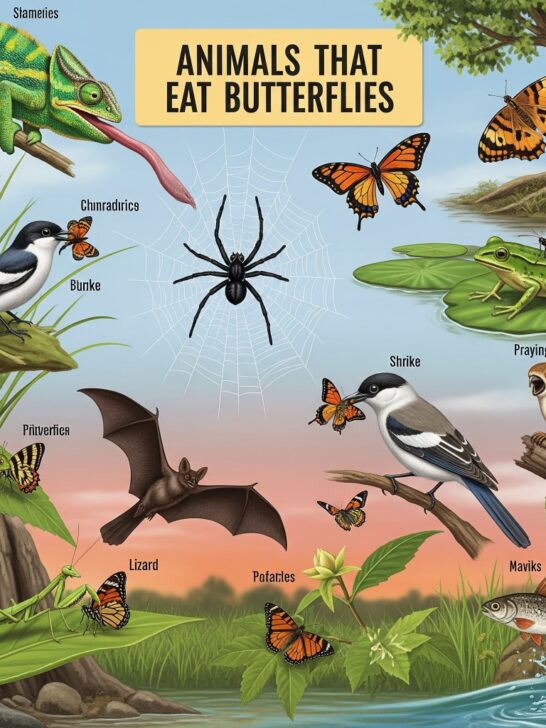Butterflies, celebrated for their vivid colors and delicate wings, are not just symbols of nature’s beauty—they are also prey for an impressive range of predators. This predation spans all stages of a butterfly’s lifecycle, from eggs to adults. Understanding butterfly predators is essential for appreciating the fragility of butterfly populations and the intricate web of ecological interactions in which they participate.
Post Contents
- Overview: Why Butterflies Get Eaten?
- 1. Birds that Prey on Butterflies
- 2. Reptiles that Prey on Butterflies
- Amphibians that Prey on Butterflies
- 3. Insects that Prey on Butterflies
- 4. Arachnids: Spiders that Prey on Butterflies.
- 5. Mammals That Prey on Butterflies
- 6. Bats that Prey on Butterflies
- 7. Parasites, Microbes, and Other Threats to Butterflies
- Butterfly Defenses Against Predation
- Predation by Lifecycle Stage
- Conclusion: The Ecological Importance of Butterfly Predators
- References
Overview: Why Butterflies Get Eaten?
Butterflies, while sometimes toxic or unpalatable, represent a protein-rich resource in many habitats. Their vulnerability differs across their lifecycle:
- Eggs are stationary and unguarded.
- Larvae (caterpillars) are slow-moving, soft-bodied, and nutritious.
- Pupae are immobile.
- Adults are more elusive, but even flight cannot protect them entirely.
Let’s explore the main predators of butterflies, categorized for clarity.
1. Birds that Prey on Butterflies
Birds are perhaps the most significant group of butterfly predators. Many insectivorous birds have the agility and vision necessary to hunt for butterflies among foliage, on the ground, and even in mid-air. Notable examples include:
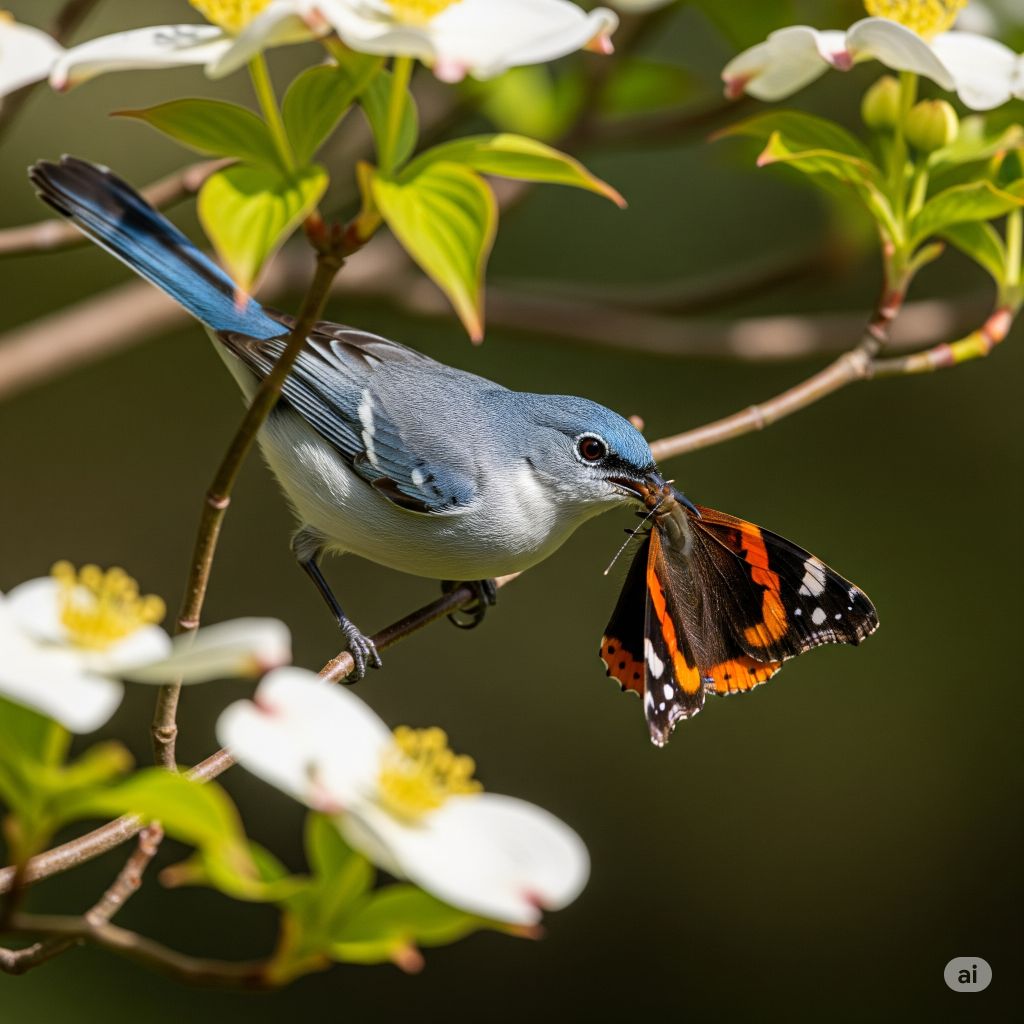
Why Birds Hunt Butterflies
Butterflies, especially during their larval and pupal stages, are rich in protein and offer a vital food source to countless bird species. Adult butterflies, though swift and sometimes distasteful due to toxins, are also targeted for their accessible energy. Birds are especially adept at finding and exploiting butterfly-rich habitats, ranging from meadows to forests and gardens, wherever flowers, leaves, and undergrowth provide camouflage for both prey and predator.
Bird Species That Prey on Butterflies
Various bird families include regular butterfly hunters. Some of the most notable insectivorous birds include:
- Warblers: Skilled foragers that pick caterpillars and adult butterflies off leaves.
- Orioles: Notorious for attacking even toxic butterflies like monarchs, sometimes selectively avoiding the most toxic body parts.
- Flycatchers: Agile aerial hunters that snatch butterflies midair.
- Grosbeaks: Robust beaks allow them to feed on larvae and adults.
- Blue Jays: Opportunistic, consuming eggs, larvae, pupae, and adults.
- Robins, Sparrows, and Tanagers: Exploit butterfly larvae during nesting season.
- Martins and Mockingbirds: Feed on a broad assortment of butterfly life stages.
Hunting Strategies
- Egg and Larva Predation: Birds such as robins and sparrows specifically seek butterfly eggs and larvae, often consuming hundreds of caterpillars daily when feeding chicks.
- Pupa Searching: Cunning birds comb beneath leaves and branches to locate well-hidden butterfly chrysalises, consuming them when found.
- Adult Attacks: Agile birds, particularly flycatchers and orioles, catch butterflies in flight or while resting on flowers. Some, including orioles, have learned to eat only the least toxic portions of species like the monarch.
- Special Adaptations: Birds like orioles and grosbeaks tolerate certain toxins found in monarch butterflies, giving them access to prey other species avoid.
Ecological Impact
Bird predation influences:
- Butterfly Population Control: Birds help keep butterfly numbers in check, especially during population booms.
- Evolution of Defenses: Butterfly mimicry (e.g., viceroy resembling toxic monarchs), bright warning (aposematic) coloration, and erratic flight patterns have all evolved in part as responses to avian predation.
- Food Webs: By consuming butterflies and their larvae, birds transfer energy up the food chain, supporting their own breeding success and indirectly impacting other plant and insect populations.
Butterfly Defenses Against Birds
To escape predation, butterflies have evolved a suite of defensive strategies:
- Aposematism: Bright warning colors signal chemical defense (e.g., monarch butterflies contain cardiac glycosides).
- Mimicry: Edible butterflies sometimes mimic unpalatable species.
- Camouflage: Both larvae and adults may blend seamlessly into their surroundings.
- Behavioral Defenses: Erratic or fast flight makes butterflies harder to catch.
Summary Table: Birds as Butterfly Predators
| Bird Family | Prey Stage | Special Strategies |
|---|---|---|
| Warblers | Larva, adult | Detailed searching among foliage |
| Orioles | Adult | Avoid toxic parts, tolerate toxins |
| Flycatchers | Adult | Catch butterflies mid-flight |
| Sparrows, Robins | Egg, larva | Forage on ground and branches |
| Grosbeaks | Adult, larva | Crush with strong beak, toxin-tolerant |
| Martins | Adult | Agile pursuit in open air |
Birds stand out as the preeminent butterfly predators, shaping both butterfly ecology and evolution in profound ways.
2. Reptiles that Prey on Butterflies
Butterflies, while celebrated for their beauty, are vulnerable to predation from a diverse group of reptiles and amphibians. These cold-blooded hunters use a combination of stealth, speed, and specialized adaptations to prey on butterflies at various stages of their life cycle.
Reptiles—including lizards and snakes—are efficient butterfly hunters. They typically target both caterpillars and adult butterflies, but rarely consume the wings, which offer little nutritional value.
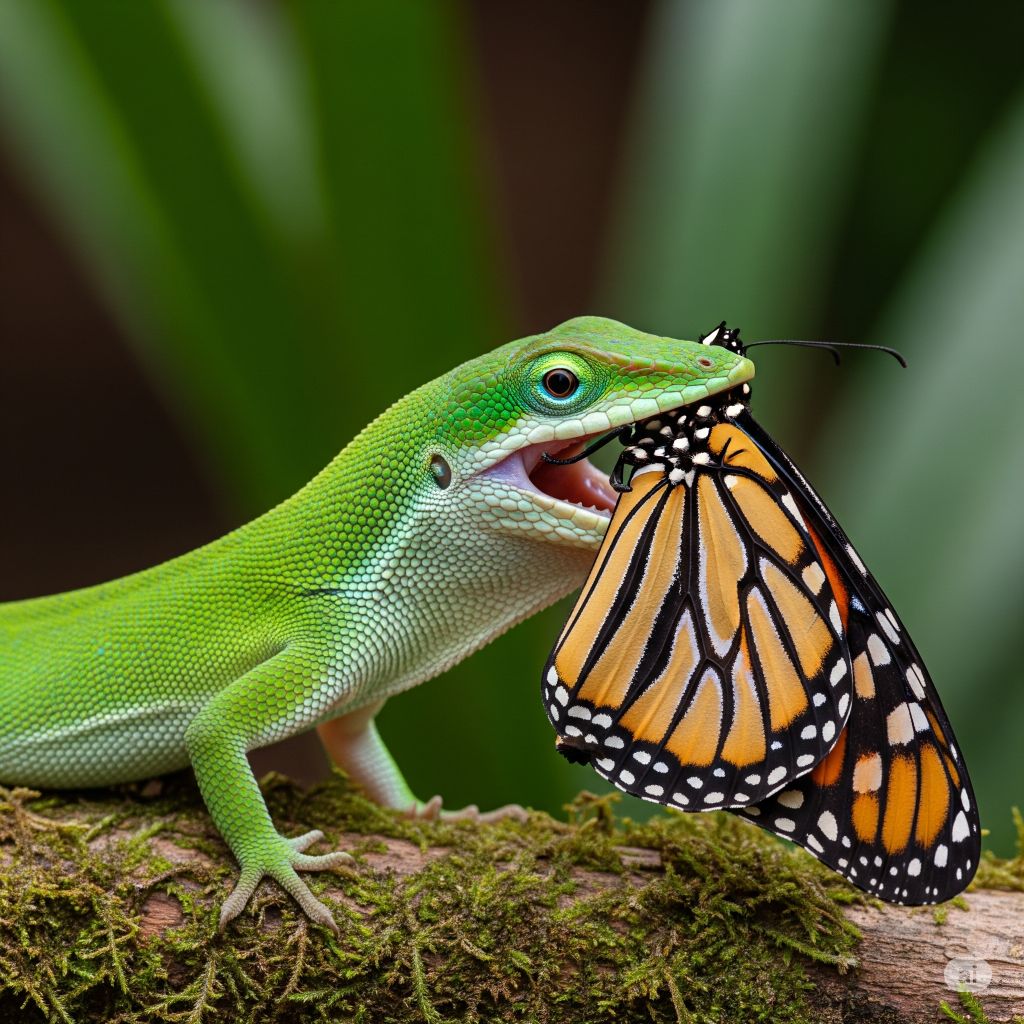
Common Butterfly-Eating Reptiles
Lizards:
Many lizard species, such as anoles and brown anoles, are known to consume butterflies and their caterpillars. Their ambush tactics and ability to blend into their surroundings make them effective insect hunters. Lizards often wait patiently on leaves or branches and strike when a butterfly comes near.
Snakes:
Although butterflies are not a primary food source for most snakes, species like the Eastern Garter Snake will opportunistically consume butterflies, especially if they land nearby. Snakes employ ambush strategies, waiting in grass or shrubs to strike quickly.
Notable Behaviors:
- Reptiles typically discard butterfly wings and focus on the bodies, which provide the most nourishment.
- Some large lizards, such as iguanas and monitor lizards, have been observed preying on butterflies and even large species like swallowtails.
Amphibians that Prey on Butterflies
Amphibians, particularly frogs, toads, and salamanders, are also significant predators of butterflies and their larvae. Their quick, sticky tongues are specially evolved to catch agile prey.
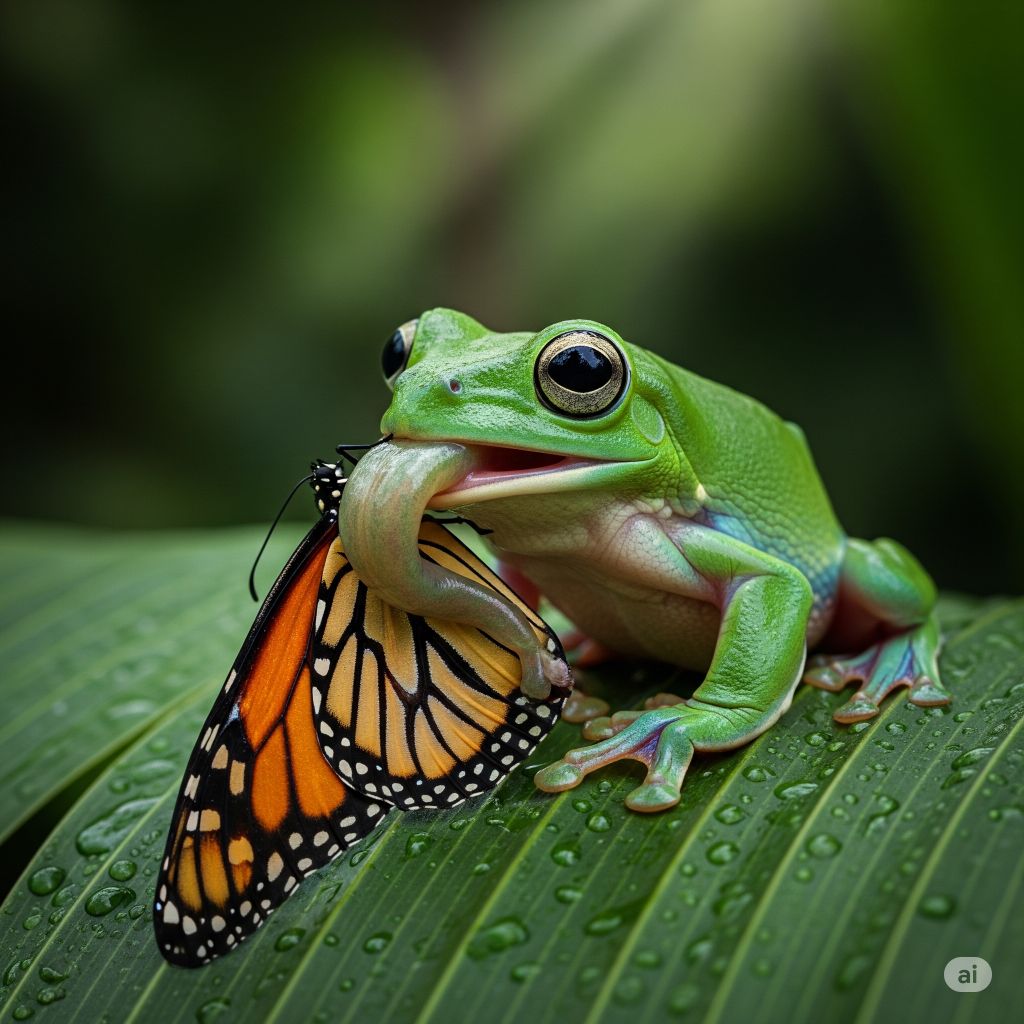
Common Butterfly-Eating Amphibians
Frogs:
Frogs, such as the American Bullfrog and Columbia spotted frog, sit patiently near water bodies and use their long, sticky tongues to snatch butterflies out of the air or off vegetation. Their ambush method and rapid reflexes make escape difficult for butterflies.
Toads:
Toads are small but agile amphibians. They can jump and catch butterflies, often hunting both caterpillars and adults. Their rapid tongue flick is usually enough to capture unsuspecting prey.
Salamanders:
While less commonly observed hunting butterflies, salamanders will eat them if given the opportunity, using their sticky tongues and stealthy approach.
Amphibian Predatory Adaptations:
- Sticky, projectile tongues for catching flying insects.
- Strong jaws capable of breaking through tough exoskeletons.
- Mucous-covered skin may provide some protection from butterfly toxins.
Summary Table: Reptiles and Amphibians That Eat Butterflies
| Group | Example Species | Hunting Method | Prey Stage |
|---|---|---|---|
| Lizards | Anole, Brown Anole | Ambush on foliage | Caterpillars, Adults |
| Snakes | Eastern Garter Snake | Ambush in grass | Adults |
| Frogs | American Bullfrog | Tongue snatch | Caterpillars, Adults |
| Toads | Great Plains Toad | Jump & tongue flick | Caterpillars, Adults |
| Salamanders | Various | Stealth & tongue | Caterpillars, Adults |
Ecological Role
Reptiles and amphibians play a crucial role in controlling butterfly populations and balancing insect communities. Their predation pressure has driven butterflies to develop defenses like camouflage, mimicry, and distasteful chemical compounds.
3. Insects that Prey on Butterflies
Insects are responsible for much of the predation on butterflies, especially during the vulnerable egg and larval stages.
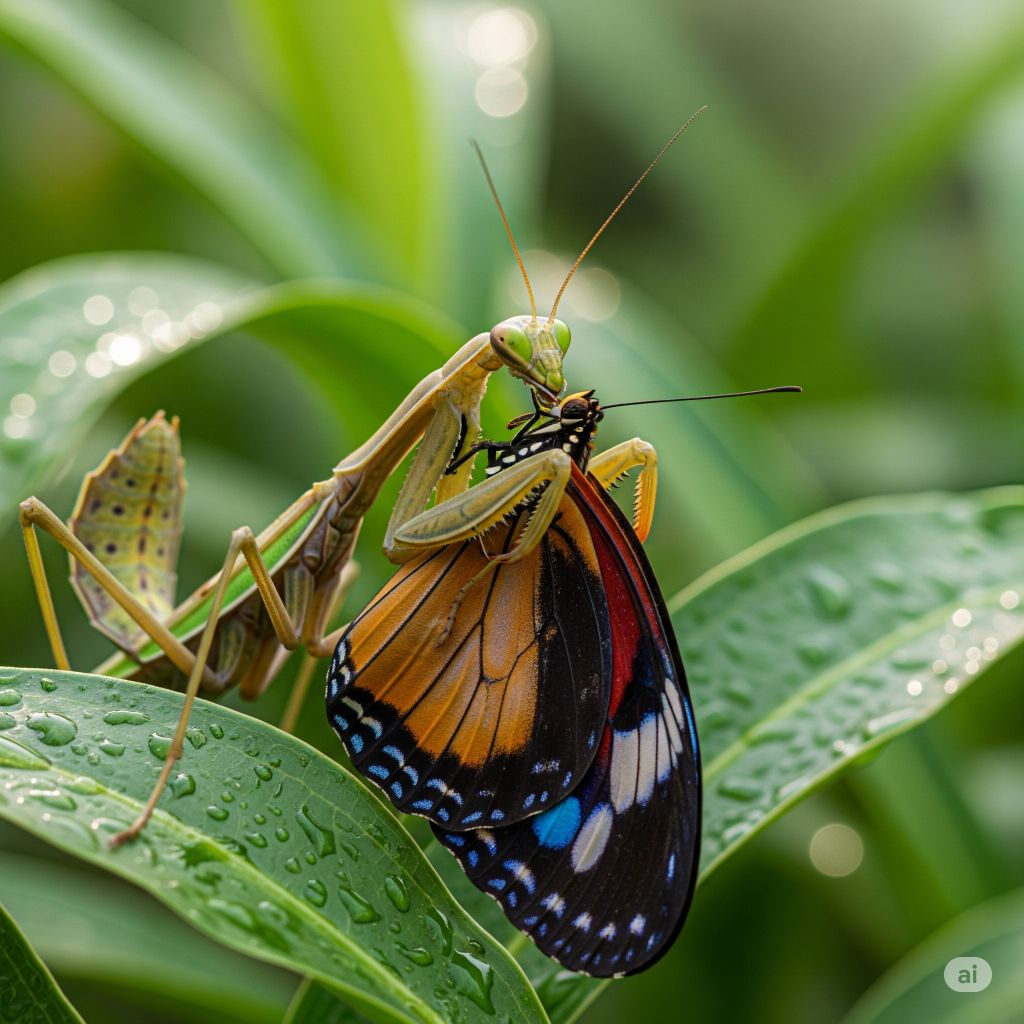
Wasps and Hornets
- Wasps such as paper wasps and hornets are ruthless hunters of butterfly eggs, caterpillars, and, on occasion, adult butterflies.
- Wasps may paralyze caterpillars to feed their larvae or attack pupae and even adult butterflies when possible. In some cases, hornets have been observed snatching adult butterflies from flowers, removing their wings, and transporting the bodies back to their nest.
Ants
- Ants, especially aggressive species like fire ants, can swarm and consume butterfly eggs, larvae, pupae, and occasionally helpless adults.
- Some ants patrol plants for prey, overwhelming butterfly larvae and eggs; in certain invasive areas, they have even become a major threat to native butterfly populations.
Praying Mantises
- Praying mantises are expert ambush predators able to remain motionless for hours, striking when a butterfly comes within reach. They eat both larvae and adults.
Dragonflies and Robber Flies
- Dragonflies are agile aerial hunters, catching adult butterflies in flight thanks to their speed and nearly 360-degree vision.
- Robber flies (family Asilidae) frequently ambush butterflies in mid-air or while resting, usually on sunny, open trails.
Ladybugs and Parasitic Flies
- Ladybugs (not just aphid eaters) will feed on butterfly eggs and small caterpillars using sharp mandibles to puncture soft tissues.
- Parasitic flies, including some tachinids, lay their eggs on caterpillars. The developing maggots consume the host from the inside, ultimately killing the caterpillar.
4. Arachnids: Spiders that Prey on Butterflies.
Spiders are among the most important invertebrate predators of butterflies, preying on them across all life stages, but particularly as adults and caterpillars. Their diverse hunting methods and web-building strategies make them a pervasive threat in nearly all terrestrial habitats where butterflies are found.
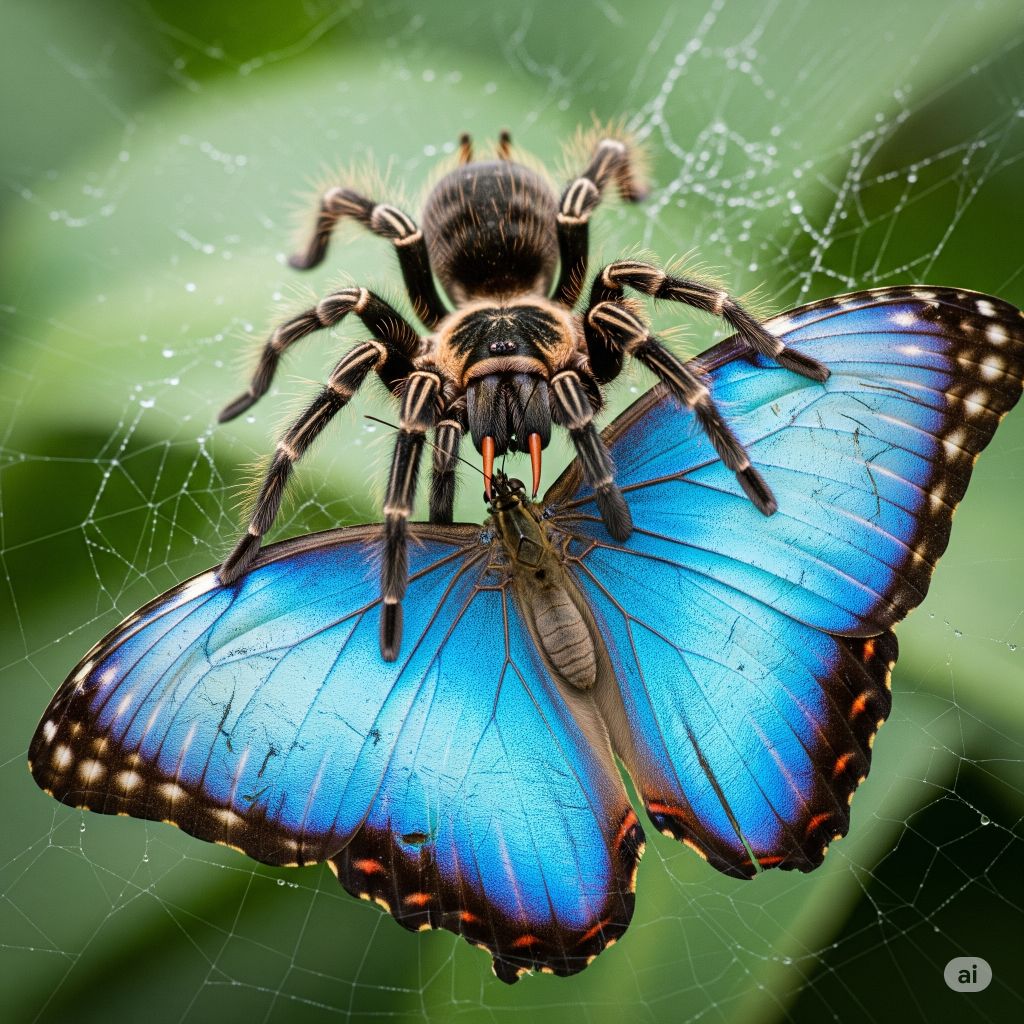
Orb-Weaver and Web-Spinning Spiders
- Orb-weaver spiders construct intricate, sticky webs between plants, often trapping unsuspecting adult butterflies and caterpillars. Smaller butterflies are usually quickly immobilized and consumed, while larger individuals may sometimes struggle free before being subdued by the resident spider.
- The presence of loose wing scales left behind in webs shows how butterfly scales can help them slip away and escape when entangled, aiding survival against this key threat.
Crab Spiders (Family Thomisidae)
- Crab spiders are classic ambush predators, commonly found lurking on flowers. They blend in with their floral surroundings, waiting motionless for butterflies to land while feeding on nectar.
- When a butterfly comes too close, crab spiders strike with their powerful front legs and inject paralyzing venom, which quickly immobilizes their prey. Their venom also contains enzymes that liquefy the victim’s internal tissues for easy consumption.
Jumping Spiders (Family Salticidae)
- Jumping spiders are visually adept, active hunters that often stalk and pounce on resting butterflies. Laboratory and field studies show that these spiders can distinguish butterfly head regions and will closely approach their prey to deliver a precise, paralyzing strike.
- Notably, research has found that certain butterfly wing patterns, especially “false heads” seen in hairstreak butterflies, can completely fool jumping spiders, diverting attacks away from vital body parts. Red-banded hairstreaks, for example, escaped 100% of encounters with jumping spiders by exploiting this visual deception.
Hunting and Ground Spiders
- Species such as Pisaura mirabilis hunt actively on low herbage, attacking butterflies that settle on vegetation. Male hunting spiders have even been observed catching and wrapping butterflies to present as courtship gifts to females during mating.
Theridiid Spiders (e.g., Enoplognatha ovata)
- These small spiders often spin haphazard webs on wildflowers or grasses and prey on summer butterflies, with localized studies documenting up to 5% butterfly mortality in small populations due to these spiders.
Evolutionary Impact: Spiders Drive Butterfly Adaptations
- Wing scales: Butterfly and moth wings are covered in easily detachable scales. This adaptation helps them escape spider webs, as the scales stick to the web but allow the butterfly to slip free, leaving characteristic “scars” on the web and their wings.
- Pattern Evolution: Recent research suggests spiders—not just birds—drive the evolution of complex butterfly coloration and patterns. Features like false heads, eyespots, and intricate mimicry are increasingly recognized as defenses shaped by spider predation as much as by avian threats.
- Behavioral Defenses: Some butterflies, notably hairstreaks, actively move portions of their wings bearing false head markings, enhancing the illusion and further distracting predator attacks.
Ecological Role
- Spiders contribute significantly to natural butterfly mortality and play a key role in maintaining ecosystem balance by controlling butterfly and moth numbers.
- Their predation pressure has influenced the astonishing diversity of defensive adaptations—behavioral, morphological, and chemical—in butterflies and other Lepidoptera.
Summary Table: Arachnids: Spiders That Eat Butterflies
| Spider Group | Strategy | Butterfly Defense | Notable Impact |
|---|---|---|---|
| Orb-weavers | Web/trap building | Detachable wing scales | Wing scale loss enables escape |
| Crab spiders | Flower ambush | Camouflage, mimicry | High predation on small butterflies |
| Jumping spiders | Visual predation, ambush | False head patterns | Drives mimicry, pattern evolution |
| Hunting spiders | Active ground hunting | Quick flight | Courtship gifts, direct predation |
| Theridiid spiders | Messy webs on flowers | None specific | 5%+ mortality in local populations |
5. Mammals That Prey on Butterflies
Mammals, while not the primary predators of butterflies compared to birds, reptiles, or insects, do play a role in butterfly predation—especially in certain regions and circumstances. Their predation generally impacts the egg, larval, and occasionally adult stages of butterflies.
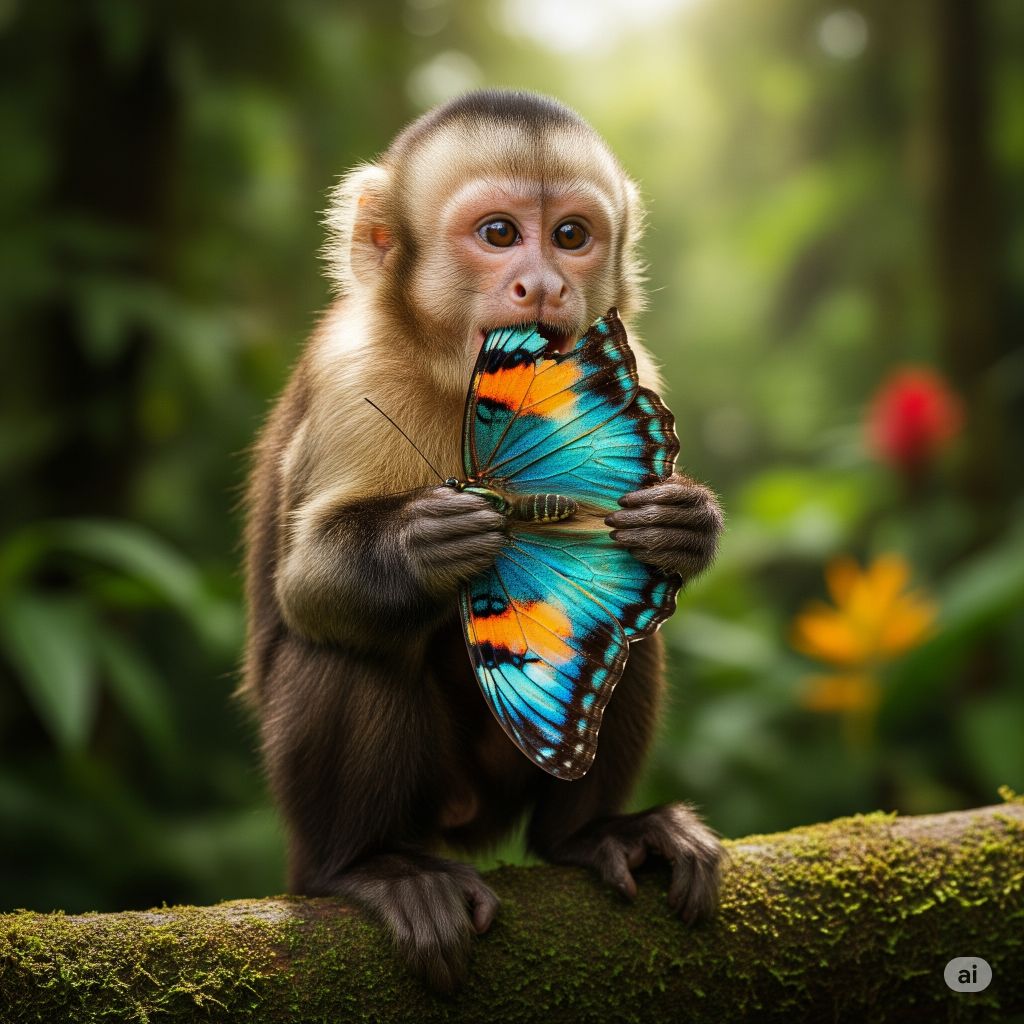
Monkeys
- Some monkey species, such as toque macaques (Macaca sinica), are documented butterfly predators, mainly consuming butterfly larvae (caterpillars). Monkeys are opportunistic foragers and will eat insects and larvae found during their search for other foods.
- These primates are observed tearing apart leaves and plants to reach hidden larvae, especially in tropical habitats where both monkeys and butterfly populations are high.
Rodents
- Small mammals such as mice and rats may consume butterfly eggs, larvae, pupae, or even adults—especially when butterflies are resting on low foliage or the ground at night.
- Rodents’ predation is often opportunistic and may be more common in disturbed habitats or urban areas where other food sources are scarce.
Humans
- In some cultures, humans (as mammals) consume caterpillars of certain butterfly and moth species, either as a protein source or delicacy. For example, the Mopane worm—a caterpillar of a moth, not a butterfly—is widely eaten in parts of Southern Africa. While this is less relevant to butterfly conservation at a global scale, it’s a notable example of direct mammalian predation on lepidopterans.
Mammalian Predation Behavior
- Mammals are typically indirect or incidental predators of butterflies, rather than specialized hunters.
- Butterfly eggs, caterpillars, and pupae are especially vulnerable if they are on or near the ground, as foraging mammals may eat them while feeding on plants or searching for other insects.
- Adult butterflies are less frequently eaten by mammals, but they can be caught if they spend time roosting at night within mammals’ reach.
Ecological Impact
- Monkeys and rodents may influence local butterfly populations by reducing the number of larvae that survive to adulthood, particularly in biodiverse regions or fragmented habitats.
- While mammals contribute to overall mortality, their impact is generally less than that of birds, reptiles, amphibians, or predatory insects.
Summary Table: Mammals as Butterfly Predators
| Mammal Group | Typical Prey Stage | Notable Behavior |
|---|---|---|
| Monkeys | Caterpillars (larvae) | Forage for larvae inside leaves and crevices |
| Rodents | Eggs, larvae, pupae, adults | Opportunistic, especially at night/on low plants |
| Humans | Larvae/caterpillars | Eaten as food in specific cultures |
While mammals are not the most significant threat to butterflies, their predation—especially by monkeys and rodents—adds an additional layer of challenge for butterfly survival, particularly at the vulnerable caterpillar and egg stages.
6. Bats that Prey on Butterflies
While bats are most strongly associated with moth predation due to nocturnal activity patterns, certain butterfly species that fly at dusk or rest at night are vulnerable to bats. These flying mammals rely on echolocation to identify and intercept their prey in darkness.
Bats are among the foremost predators of flying insects, especially moths, but their impact extends to other night-active prey—including some butterfly species that are active at dusk or roost at night. Their unique hunting strategy is based on echolocation: bats emit high-frequency sound waves that bounce off potential prey, allowing them to locate and pursue insects with great precision in the dark.
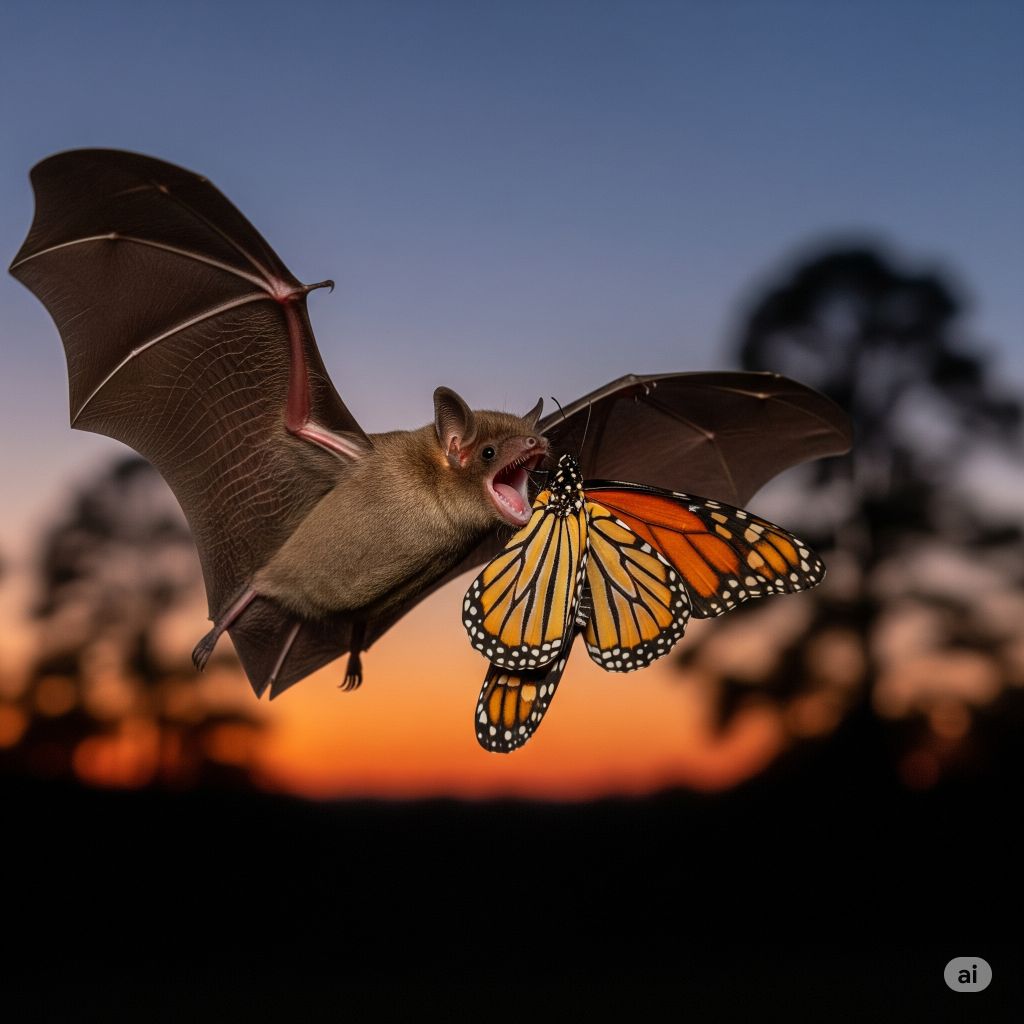
Hunting Behavior and Prey Selection
- Echolocating bats exploit a broad range of food sources, with some specializing in aerial hawking (catching insects mid-air), others gleaning prey from surfaces, and some even trawling insects from water.
- They dynamically adjust their echolocation calls for different hunting scenarios, tuning call intensity and frequency to maximize their chance of detecting and catching prey—even those with minimal echoes, such as small moths or butterflies.
- Bats often target larger, energy-rich prey on the ground when possible, despite a lower capture success rate, because ground-dwelling insects offer higher caloric returns.
- Aerial hawking remains essential, however, as capture rates in the air are much higher.
The Co-Evolution of Bats and Insect Prey
- Much of the research into bat predation focuses on moths. Over millions of years, moths have evolved sophisticated defenses—including the ability to hear bat sonar, evasive flight maneuvers, and even jamming or warning signals—due to the intense predation pressure from bats.
- Some daytime butterflies that rest at night or are crepuscular (active at dawn/dusk) are also vulnerable to bats, especially in regions where butterfly roosts are accessible at night.
Sensory and Motor Adaptations
- Bats possess rapid, highly flexible sensory-motor systems, enabling them to react in milliseconds to dodge obstacles and intercept evasive prey.
- As they close in on a target, bats narrow their echolocation “focus,” boosting the rate of calls to increase information flow and lock onto a moving insect, much like how predatory birds focus visually on fast-moving prey.
Ecological Impact
- By feeding on thousands of insects per night—including moths, beetles, and some butterflies—bats play a crucial role in insect population control and ecosystem balance5.
- Their presence as top nocturnal insect predators influences the evolution and behavior of many nocturnal insects, driving the development of auditory organs and other defensive strategies in their prey.
Summary Table: Bats as Butterfly and Moth Predators
| Aspect | Detail |
|---|---|
| Key hunting strategy | Echolocation (sonar-based) to locate flying and ground-dwelling prey in the dark |
| Typical prey | Mostly moths, but also beetles, flies, and crepuscular/nocturnal butterflies |
| Behavioral adaptations | Dynamic call adjustment, rapid sensory-motor coordination, high-precision flight |
| Insect defenses | Hearing bat calls, erratic flight, dropping to ground, producing warning or jamming signals (mainly in moths) |
| Ecological significance | Main nocturnal insect predators, key in regulating insect populations |
Bats’ evolutionary arms race with their insect prey has led to remarkable adaptations on both sides, shaping the behavior, physiology, and ecology of nocturnal insects, including moths and, to a lesser extent, butterflies.
7. Parasites, Microbes, and Other Threats to Butterflies
Butterflies, though beautiful and seemingly fragile, face a multitude of threats that go beyond visible predators. Parasites, microbes, and other environmental challenges can have significant impacts on their survival and population dynamics.
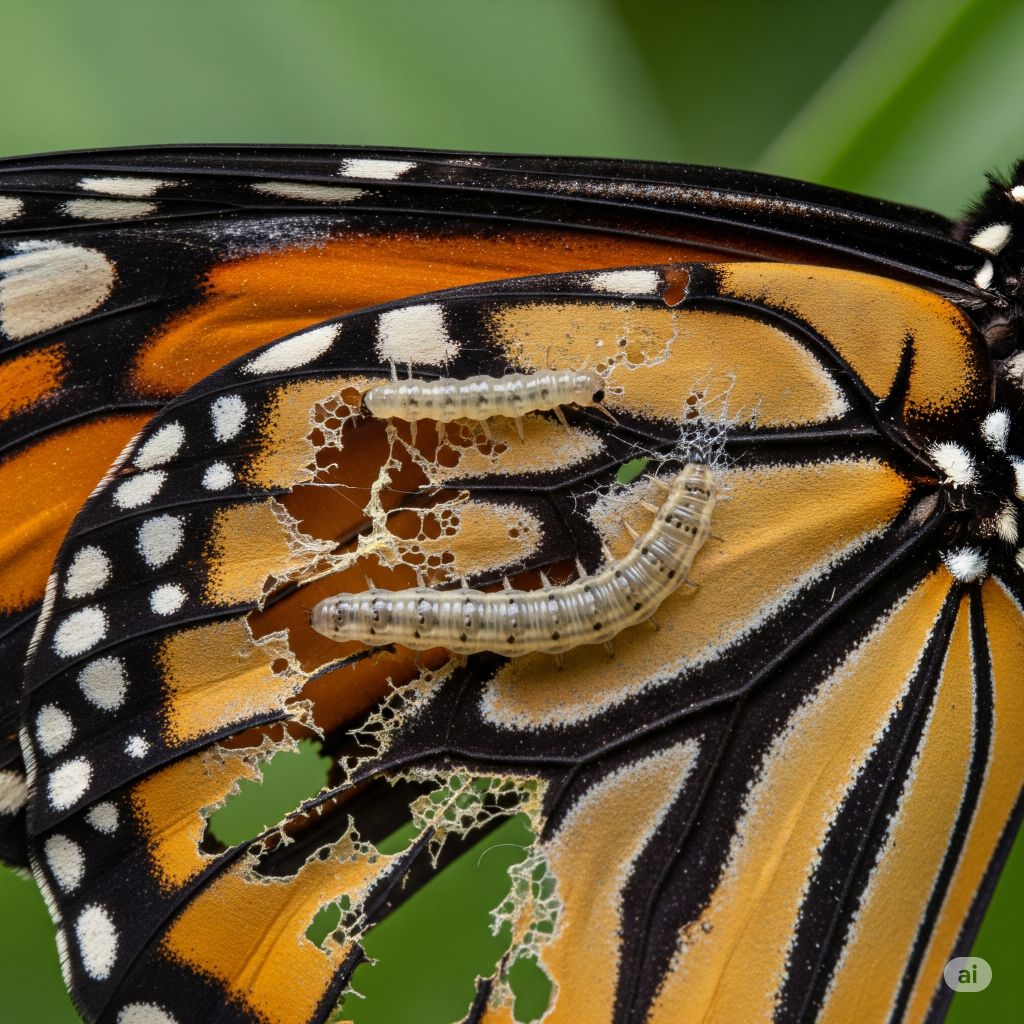
Protozoan Parasites
- Ophryocystis elektroscirrha (OE)
- This protozoan is one of the most well-known parasites of monarch and queen butterflies.
- OE infects caterpillars when they ingest spores on the surface of eggs or milkweed leaves. After ingestion, the parasite invades the caterpillar’s gut, multiplies, and can cause severe deformations or even death during the butterfly’s emergence from the chrysalis.
- Spores from infected adults contaminate milkweed, continually spreading the infection. Some heavily infected adults are too weak to fully emerge and die within their pupal cases, while others that survive are less capable of flight and have shortened lifespans.
- Notably, the O.E. infection rate in eastern monarchs has risen from less than 1% in 1968 to up to 10% today, signaling a growing ecological concern.
Parasitic Wasps and Flies
- Parasitoid wasps inject eggs directly into butterfly eggs or larvae. The wasp larvae develop inside, eventually consuming and killing the host.
- Tachinid flies lay eggs on caterpillars; fly larvae burrow inside, consuming the caterpillar and killing it as they emerge.
Parasitic Butterflies
- Some butterfly species, such as Niphanda fusca, have evolved “cuckoo” strategies, deceiving ants into raising their larvae by mimicking chemical signals. These larvae feed on resources provided by the ants, a form of parasitism that affects both ants and butterflies.
Microbes
Butterfly Microbiome
- Contrary to expectations, the gut microbiomes of butterflies play little to no essential role in their larval survival or development.
- Experiments show that manipulating or disrupting the gut microbial community in butterfly larvae does not significantly affect their growth, metamorphosis, or survival, which is unusual among insects.
Pathogenic Microbes
- Butterflies can also fall victim to bacterial, viral, and fungal pathogens. These microbes may cause diseases that can kill eggs, caterpillars, or adults, although most significant population-level impacts are attributed to parasites and environmental threats.
- Floral microbes (on nectar plants) can modify nectar quality, indirectly affecting butterflies’ feeding efficiency and potentially leading to secondary threats.
Summary Table: Threats to Butterflies
| Threat Type | Example Organisms/Factors | Impact on Butterflies |
|---|---|---|
| Protozoan Parasites | Ophryocystis elektroscirrha (OE) | Weakens, kills larvae/adults, lowers fitness |
| Parasitoids | Wasps, tachinid flies | Kill eggs, larvae, and pupae |
| Pathogenic Microbes | Bacteria, fungi, viruses | Cause disease/death (more research needed) |
| Habitat Loss | Urbanization, deforestation, intensive farming | Reduces breeding/nourishment resources |
| Pesticides/Herbicides | Neonicotinoids, glyphosate | Direct mortality, contaminates foodplants |
| Climate Change | Rising/extreme temperatures, erratic rainfall | Disrupts life cycle/migration |
| Parasitic Butterflies | Niphanda fusca, others | Compete for resources, exploit other insects |
Butterfly Defenses Against Predation
Despite the host of dangers, butterflies are not defenseless. Their evolutionary adaptations include:
- Aposematic coloration: Bright warning colors (such as those on monarchs) signal toxicity to potential vertebrate predators.
- Mimicry: Edible butterflies sometimes resemble unpalatable species to trick predators (e.g., viceroy resembling monarch).
- Camouflage: Many butterfly species, particularly in the caterpillar stage, have cryptic coloration that helps them blend in with leaves or bark.
- Behavioral evasions: Erratic, unpredictable flight patterns make butterflies harder targets for birds and dragonflies.
Predation by Lifecycle Stage
| Life Stage | Main Predators | Notes |
|---|---|---|
| Egg | Ants, wasps, birds, beetles | Stationary, easiest prey for small predators |
| Larva (Caterpillar) | Birds, wasps, ants, beetles, rodents, monkeys | Often subject to the highest mortality rates; some birds can eat hundreds daily |
| Pupa | Birds, rodents, ants, wasps, parasites | Hidden, but immobile and defenseless |
| Adult | Birds, spiders, dragonflies, praying mantises, lizards, frogs, snakes, bats, monkeys | Fast but still vulnerable—visual hunters dominate this stage |
Conclusion: The Ecological Importance of Butterfly Predators
Predators play a crucial role in regulating butterfly populations and supporting complex food webs. Their actions influence not only the number of butterflies but also their evolutionary paths—by selecting for better camouflage, toxicity, and behavioral adaptations. In turn, butterflies support predators with a vital food resource, especially during the breeding seasons of insectivorous birds and the growth periods of carnivorous insects.
Predation is neither good nor bad but an essential part of natural balance. Understanding the interactions between butterflies and their many predators deepens our appreciation for nature’s complexity and the teeming life of a single meadow or garden, where survival is an endless dance of adaptation, opportunity, and risk.
References
- https://le.kloofconservancy.org.za/what-eats-butterflies-and-moths/
- https://homework.study.com/explanation/which-animals-eat-butterflies.html
- https://www.jstor.org/stable/43421147

94% of pet owners say their animal pal makes them smile more than once a day. In 2007, I realized that I was made for saving Animals. My father is a Vet, and I think every pet deserves one. I started this blog, “InPetCare”, in 2019 with my father to enlighten a wider audience.
